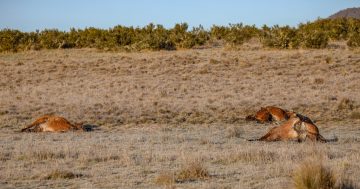
There are calls for the NSW Government to produce a consistent wild horse management plan. Photo: Supplied.
Pressure is mounting for the NSW Government to disclose its updated strategy for management of wild horse populations across alpine regions of NSW.
The matter has been roused from its Christmas sleep by the ACT Government and conservation groups after Parks Victoria released the draft Feral Horse Action Plan 2021 on 26 March, to address feral horse impacts and protect the Alpine National Park.
They’re now calling for a zero-tolerance policy, with anything less enacted by NSW considered to have cross-border implications.
ACT Minister for Planning and Land Management Mick Gentleman said the NSW Government must come to the table with a stronger consistent management plan.
“It’s becoming more difficult to keep feral horses out of the ACT’s parks as NSW populations grow – the last count found 14,000 horses across the border in Kosciusko,” he said.
Invasive Species Council CEO Andrew Cox said the Victorian Government’s plans to use all possible humane methods to limit feral horses were in stark contrast to the NSW Government, “which is failing dismally to stop the spread of feral horses on their side of the border”.
Citing a Frontier Economics report, Mr Cox said inaction could impose further environmental, economic and social costs across the border in Victoria and the ACT.
Victoria’s draft Feral Horse Action Plan 2021 sets out the proposed approach to improve management and reduce damage to vulnerable natural and cultural values of the Victorian Alps.
The 54-page document is a revision of the state’s 2018-2021 Feral Horse Strategic Action Plan, driven by continued wild horse impacts on native alpine wildlife and habitats, extensive habitat loss from the Black Summer bushfires, and the limited progress to date of current management methods.
The draft plan outlines the preferred methods of managing feral horses, including trapping and rehoming, tightly managed shooting, and exclusion fencing.

Victoria’s draft action plan follows the ACT Government’s no-tolerance feral horse policy. Photo: Supplied.
A key measure is eradication of the estimated 100-strong Bogong-Cobungra wild horse population which, in 2020, saw protesters gather in the high-country to prevent a shooting cull of the mob by Parks Victoria, an issue that ricocheted straight into the Supreme Court of Victoria.
Ground shooting is considered “the most humane, safe and effective method available and is an acceptable technique”. In extraordinary circumstances, aerial shooting is another option.
Parks Victoria says many aspects of the management approach, which is open for public comment until Friday, 23 April, are consistent with previous plans.
These include the need to control wild horses in the national park, major impacts on the natural environment, legislative and moral obligations to undertake this work, and the available range of control methods.
In welcoming Victoria’s new draft plan, Mr Gentleman said strong horse management policies are essential to protect sensitive alpine ecosystems.
“Feral horses are one of the largest causes of environmental degradation in Australia’s alpine parks,” he said. “Alpine wetlands filter the water that flows into our drinking catchments, and increasing feral horse numbers risks severely damaging these sensitive areas.”
Mr Gentleman said Namadgi’s high-country bogs and associated fens were added to the ACT’s threatened ecological communities list in 2020, based on advice from the ACT Scientific Committee.

The internationally significant Ginini Flats Wetlands Complex is the largest intact sphagnum bog in the Australian Alps. Photo: Supplied.
“Victoria’s new plan will give their ecologists and parks staff more options to effectively manage horse populations within their borders,” he said
“While it’s positive the NSW Minister for the Environment has promised to reduce these numbers, we need swift action beyond ineffective trapping and rehoming methods.”
ACT Minister for the Environment Rebecca Vassarotti said the environment doesn’t recognise state boundaries, meaning a consistent joint approach is the only way to protect the ACT environment from pests.
“It’s now time for the NSW Government to stop protecting destructive feral horses at the expense of our environment and unique biodiversity,” she said.
Mr Cox said the newly proposed Victorian measures provide a sensible and balanced approach to reducing feral horse numbers in the Australian Alps.
He said the draft action plan follows in the footsteps of the ACT Government’s strong no-tolerance policy but leaves NSW, which is still operating under a 2008 management plan, in the dark ages.
“Both the Victorian and ACT governments have been forced to revise their horse management plans to deal with an escalation in feral horse numbers caused by inadequate control measures across the Australian Alps,” said Mr Cox.
“All three state governments – Victoria, NSW and the ACT – share management of the Australian Alps so NSW needs to stop dragging its feet on feral horse management and release its own updated horse management plan, which was promised more than a year ago, to the public.”
Original Article published by Edwina Mason on About Regional.





















